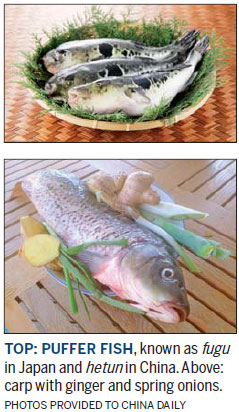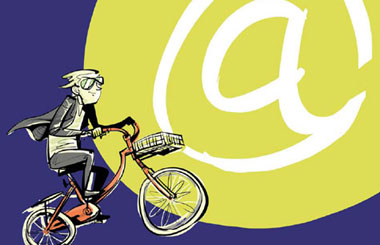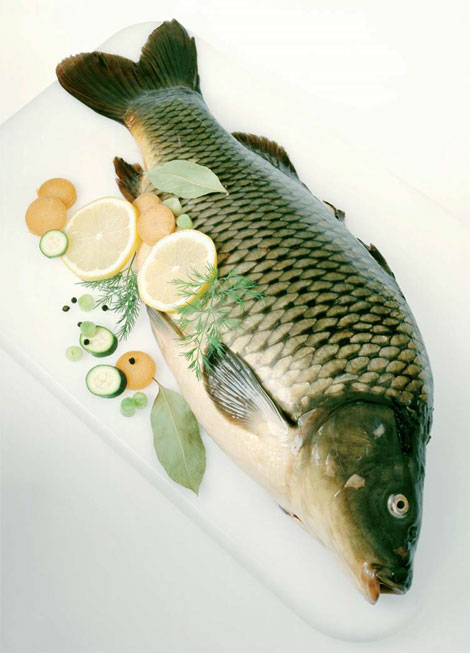So good it can kill
Updated: 2016-04-08 08:21
By Pauline D. Loh(China Daily Europe)
|
|||||||||
Editor's note: To understand China you have to sit down to eat. Food is the adhesive that holds the Chinese social fabric together. In the face of increasing globalization, food is also one of the last strong visages of community and culture.
As a young student in the United Kingdom, I ate fish often. But it was always disguised, covered in crispy batter or appearing as neat, geometrically perfect pieces of breaded "fish fingers".
All the most succulent bits were missing. Where was the head? Where was the tail? Where were the tender, fatty belly bits that my grandfather always reserved for me?
|
|
That was the first time culinary culture shock set in.
Chinese almost everywhere eat the whole fish, wasting nothing. A table-sized fish would be steamed or cooked whole and served at the table. The meal is only complete when the skeleton is picked totally clean.
A bigger fish may be cut up and braised or cooked in soup, bones included.
Fish may be filleted and sliced thinly to be used in stir-fries, but the head and bones are always reserved, to be used in a rich fish stock.
The fish stock is a culinary lesson in itself. The best broth is made by frying the bones with aromatics such as ginger and onions. Then, boiling water is added to the pan and kept on a rolling boil until a milky-white, fragrant stock emerges.
But the real art of eating fish is knowing when to eat it.
Spring is when most fish are invigorated by the growing warmth, and fattening up for the most important ritual in their lives - mating. From the thawing lakes and rivers in the north to the rich river deltas along the eastern seaboard, the waters are coming alive with fat fish.
These may include fishes that are seldom eaten in other seasons such as the knife fish of the Huangpu River and the more widely distributed puffer fish.
Puffer fish, known as fugu in Japan, is called hetun in China. This translates literally to "river hog", a term that references both its rotundity and its epicurean desirability.
In Yangzhou especially, the usually measured enthusiasm of the city's scholarly gourmets rises to fever pitch. The best puffer fish are produced around the region.
Scholars and poets have paid tribute to the puffer fish for as long as they could hold a brush, including the famous Song Dynasty (960-1279) poet Su Dongpo, known for his love of good food as much as for his literary works.
There was a story that once related how Su sat back in his chair after a meal of hetun, only to lean forward again to pick up another delicious morsel.
"This is to die for," he reputedly said.
And it's true.

The puffer fish needs special skill to prepare because its blood, ovaries, liver and intestines are so poisonous they can kill.
According to a senior colleague whose wife's grandfather was a certified puffer fish chef in Yangzhou, the preparation takes much skill.
These days, trained chefs must display proper certificates and in time-honored tradition must personally appear before the gathered diners and eat the first piece of the fish to prove credibility and skill.
Yangzhou men love this risky delicacy so much that they are known as its "cousins".
According to another young Yangzhou gourmet, the fish can be cooked in a white stock or red-braised with slightly fermented hard bean curd. Sometimes, tender alfalfa sprouts are added.
Both colleagues agree that puffer fish skin is "good for the belly" in that the little bristles on the skin can do an internal cleaning job.
Nowadays, most puffer fish are farmed to satisfy growing demand and their toxic properties significantly reduced and controlled.
My family, as southerners, have always eaten carp in spring. The Cantonese carp is as fat as it is long during this season, with its belly hugely distended by roe and milt.
Our favorite way was to braise it with plenty of sliced ginger and the first fresh green onions sprouting after the winter cold.
My grandmother first would fry the whole fish, scales and all, until it was crispy and golden brown. According to her, the scales had a layer of fat underneath that would keep the flesh tender and moist.
The entire fish would then be placed on its bed of aromatics and gently braised until cooked. I can still taste the moment when the clay pot cover was lifted and fragrance of fresh carp filled the room.
The highlight was always when grandfather broke open the fish belly and lifted out the first spoonful of golden roe.
Sometimes the carp was a boy. In that case, its belly would be filled with smooth, silky, snow-white milt. This was a rare delicacy.
Now that I live in Beijing, the carp is one of the few freshwater fishes available in the local markets. The northern variety, though, seems longer and leaner, and I have yet to see either roe or milt.
My husband tells me that the Yellow River is famous for its huge carp and that the region has special carp banquets. I look forward to my first taste of Yellow River carp, but my palate loyalty probably always will stay with the short, fat Pearl River Delta carp of my childhood.
Curiously enough, my spouse and I have chosen to retire in Yunnan province, where carp is another spring specialty.
Yunnan's tribal minorities cultivate rice in terraces cut out of the hills. In spring, when the rice plants flower, the carp in the flooded rice terraces feast on the fallen blossoms and grow fat. That is when they are harvested and processed.
The fresh carp is halved lengthwise and marinated with mountain peppers, wild ginger, chilies and regional herbs. They are then salted and packed into specially made wooden casks or clay urns. This ensures a year's supply of fish.
paulined@chinadaily.com.cn
Today's Top News
China gains stakes in Piraeus Deal
Riding on emotions
When the Bard met his Chinese match
EU to benefit from China's 13th Five-Year Plan
New app lets users text like Shakespeare
Zhubi Reef lighthouse comes to life
Huawei picks UK for global launch of new phone
Social media fury after woman claims attack in hotel
Hot Topics
Lunar probe , China growth forecasts, Emission rules get tougher, China seen through 'colored lens', International board,
Editor's Picks

|

|

|

|

|

|








